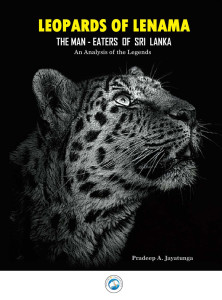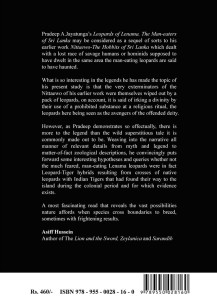Description
LEOPARDS OF LENAMA
THE MAN-EATERS OF SRI LANKA
An Analysis of the Legends
Introduction
The largest of the native felids in Sri Lanka is the leopard – Panthera pardus Kotiya. Unlike in neighbouring India, now there are no tigers or lions native to Sri Lanka, although Pleistocene period fossils of both these big cats have been found at several locations in the island. The story of the zoo- archaeologists establishing the existence of the lion and, especially, the tiger in pre-historical Sri Lanka is a fascinating case of unraveling and rectifying misidentifications but, what is important for the purpose of this study is that the leopard is the only indigenous big cat Sri Lanka has at present, and ever had during historical times.
The legend of the leopards of Lenama is basically two-fold – having what could be described as super-natural and crypto-zoological dimensions. The former is the destruction of a Vedda clan by maneating leopards due to divine displeasure incurred by the unfortunate aborigins. The latter consists of the belief (augmented by several eye-witness accounts) among the jungle villagers of the area that Lenama leopards are distinct from the other leopards; being larger in size and having different markings on the skin in some parts of the body, in addition to certain unusual behavioural traits.
The tale of the leopards acting as the instruments of a god’s vengeance is interesting not only due to the fact that it demonstrates the strength of the belief among the jungle folk in the might of the deities. Other than a handful of exceptions – the most famous being the Punani man-eater – the Sri Lankan leopard does not have a reputation of being a hunter of humans. According to the Lenama legend, it was not a solitary man-eater which was responsible for the destruction of the Vedda settlement, but a group of the big cats. If it really took place, the massacre commited at Lenama by a pack of leopards would be unique among the records of feline behaviour, surpassing even the gruesome accounts of the two man-eating lions of Tsavo in Kenya that hunted in tandem. There have been rare instances where tigers had involved their partners or adolescent/full-grown offspring in their man-eating careers. But, nowhere in the world has a leopard (which, unlike the socially-living lion, is a solitary predator) been reported to have paired with another-let alone a pack- to prey on humans.





Reviews
There are no reviews yet.